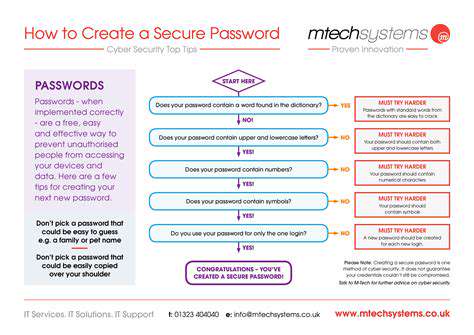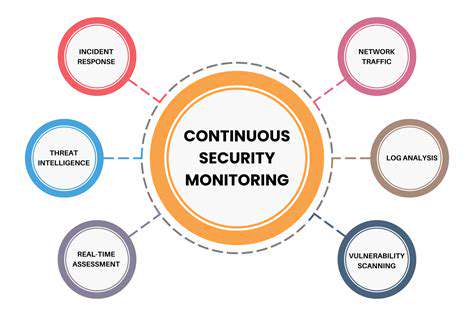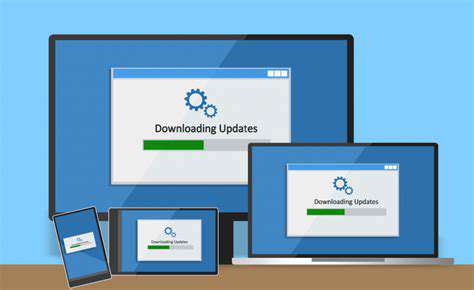How to Create a Strong Home Wi Fi Password
Understanding the Importance of Complexity
A strong password is the first line of defense against unauthorized access to your home Wi-Fi network. Beyond simply choosing a memorable combination of letters and numbers, a truly robust password incorporates complexity that makes it virtually impenetrable to automated attacks. Think about how many different passwords you use in your daily life; each one should have a distinct and intricate design, avoiding patterns or easily guessable sequences.
Password complexity is not merely about length; it's about a combination of upper and lowercase letters, numbers, and symbols. A password like MyStrongPassword123! is significantly stronger than password123 due to the inclusion of mixed-case, numbers, and a symbol. This added complexity significantly hinders brute-force attacks and other automated attempts to crack your password.
Utilizing Passphrase Strategies
While a long, complex password can be challenging to remember, a passphrase offers a balance between security and usability. A passphrase is a sentence or phrase, like MyDogIsAFancyGoldenRetriever that is more memorable than a random string of characters. Using a passphrase allows you to combine words in a meaningful way, making it harder for hackers to guess, while remaining easy enough to recall for you.
For an added layer of security, consider incorporating numbers and symbols into your passphrase. For example, MyDogIsAFancyGoldenRetriever123! combines a memorable phrase with numerical and symbolic elements for an even more robust password.
Implementing Two-Factor Authentication (2FA)
Two-factor authentication (2FA) adds an extra layer of security to your home Wi-Fi network, making it far more difficult for intruders to gain access, even if they have your password. 2FA typically involves receiving a temporary code via text message or authenticator app, requiring both your password and the code for successful login. This extra verification step makes unauthorized access significantly less likely.
Regular Password Updates and Rotations
Regularly updating your Wi-Fi password is a crucial security measure. Hackers are constantly developing new methods to crack passwords, and what might be secure today could be vulnerable tomorrow. Establish a schedule for password changes, perhaps every three months or six months, to keep your network protected from emerging threats. This proactive approach helps to maintain the integrity of your network's security.
Password rotation is an essential practice. Avoid reusing passwords across multiple accounts, including your home Wi-Fi. Each password should be unique and complex, enhancing the overall security posture of your network. This prevents a breach in one account from compromising others.
Choosing a Secure Wi-Fi Network Name (SSID)
While your password is paramount, the name of your Wi-Fi network (SSID) also plays a role in your overall security strategy. Avoid using easily identifiable names like GuestNetwork or your house number. A unique, non-obvious SSID makes it more challenging for intruders to target your network.
Consider using a unique, non-obvious SSID that does not reveal personal information. A strong and randomized SSID name adds another layer of protection beyond your password, making it harder for hackers to identify and target your network.
Utilizing a VPN for Enhanced Security
A virtual private network (VPN) adds an extra layer of security to your home Wi-Fi connection by encrypting your internet traffic. This encryption makes it far more difficult for hackers to intercept your data, even if they gain access to your Wi-Fi network. Using a VPN creates a secure tunnel for your online activity, protecting your data from potential threats.
A VPN provides a secure and encrypted connection to the internet, effectively masking your IP address and encrypting your data. This heightened privacy and security are especially beneficial when using public Wi-Fi networks or accessing sensitive information, ensuring your data remains protected, regardless of the network you're connected to.
Vitamins play a crucial role in various bodily functions, including energy production. Many vitamins act as coenzymes, assisting enzymes in metabolic processes that convert food into usable energy. For instance, vitamin B complex vitamins, including thiamin (B1), riboflavin (B2), niacin (B3), pantothenic acid (B5), and others, are essential for the breakdown of carbohydrates, fats, and proteins, releasing energy for cellular activities. Adequate intake of these vitamins is vital for maintaining energy levels throughout the day and supporting overall health.
Protecting Your Network: Router Settings and Updates
Router Configuration for Enhanced Security
Proper router configuration is paramount to a strong home Wi-Fi network. This involves more than just setting a password. Understanding and implementing crucial settings like network encryption (WPA3 is highly recommended), disabling remote administration, and configuring a strong network name (SSID) are vital steps. By meticulously configuring your router, you significantly reduce the risk of unauthorized access, protecting your personal data and devices from potential threats. These steps are essential for creating a secure and reliable Wi-Fi environment in your home, preventing malicious actors from infiltrating your network.
Furthermore, regular checks and updates for your router's firmware are critical. Outdated firmware can leave your network vulnerable to known exploits. Manufacturers often release updates that patch security holes and improve performance. Actively seeking and applying these updates is a proactive measure to maintain a robust and secure network infrastructure. Staying informed about firmware updates and promptly installing them is a key aspect of safeguarding your network's overall security.
Regular Router Updates and Security Audits
Routine updates for your router's firmware are crucial for maintaining a secure network. These updates often address vulnerabilities discovered by security researchers. By keeping your router's software current, you mitigate the risk of exploits and ensure that your network is protected against the latest threats. Regular updates act as a proactive measure against potential security breaches, safeguarding your network's integrity and the sensitive information it carries.
Periodic security audits of your router's configuration are equally important. This involves reviewing your router settings for any unusual activity or potential weaknesses. Look for any unauthorized devices connected to your network, review your firewall settings, and ensure that your network encryption is strong. These steps help you identify and address potential security gaps before they can be exploited by malicious actors. Regular monitoring and analysis of your router's configuration are essential for maintaining a strong and secure home network.
In addition to firmware updates, consider periodically changing your router's password. This adds another layer of security, making it more difficult for unauthorized users to access your network. Using a strong, unique password and changing it regularly significantly enhances your network's protection against unauthorized access and provides an extra layer of security in your home network environment. Combining this with other security measures like strong passwords and updated firmware creates a comprehensive defense against cyber threats.
Implementing these updates and security audits ensures your network remains a secure and reliable platform for your devices and data. It is a best practice to prioritize security and maintain a strong, up-to-date network environment.

Read more about How to Create a Strong Home Wi Fi Password
Hot Recommendations
- Review: The New [Specific Brand] Smart Lock Is It Secure?
- Best Budget Studio Monitors for Music Production
- Top Flight Simulation Peripherals (Joysticks, Throttles, etc.)
- Top Portable Scanners for Document Management On the Go
- Reviewing the Latest Smart Air Purifiers for Your Home
- Best Portable Photo Printers for Travelers and Memory Keepers
- The Future of Personal Transportation Beyond Cars (Hyperloop, eVTOL)
- Top Network Monitoring Tools [Free & Paid Options]
- Understanding the Tech Behind mRNA Vaccines [A Look Inside]
- Guide to Choosing the Right Gaming Chair for Ergonomics











